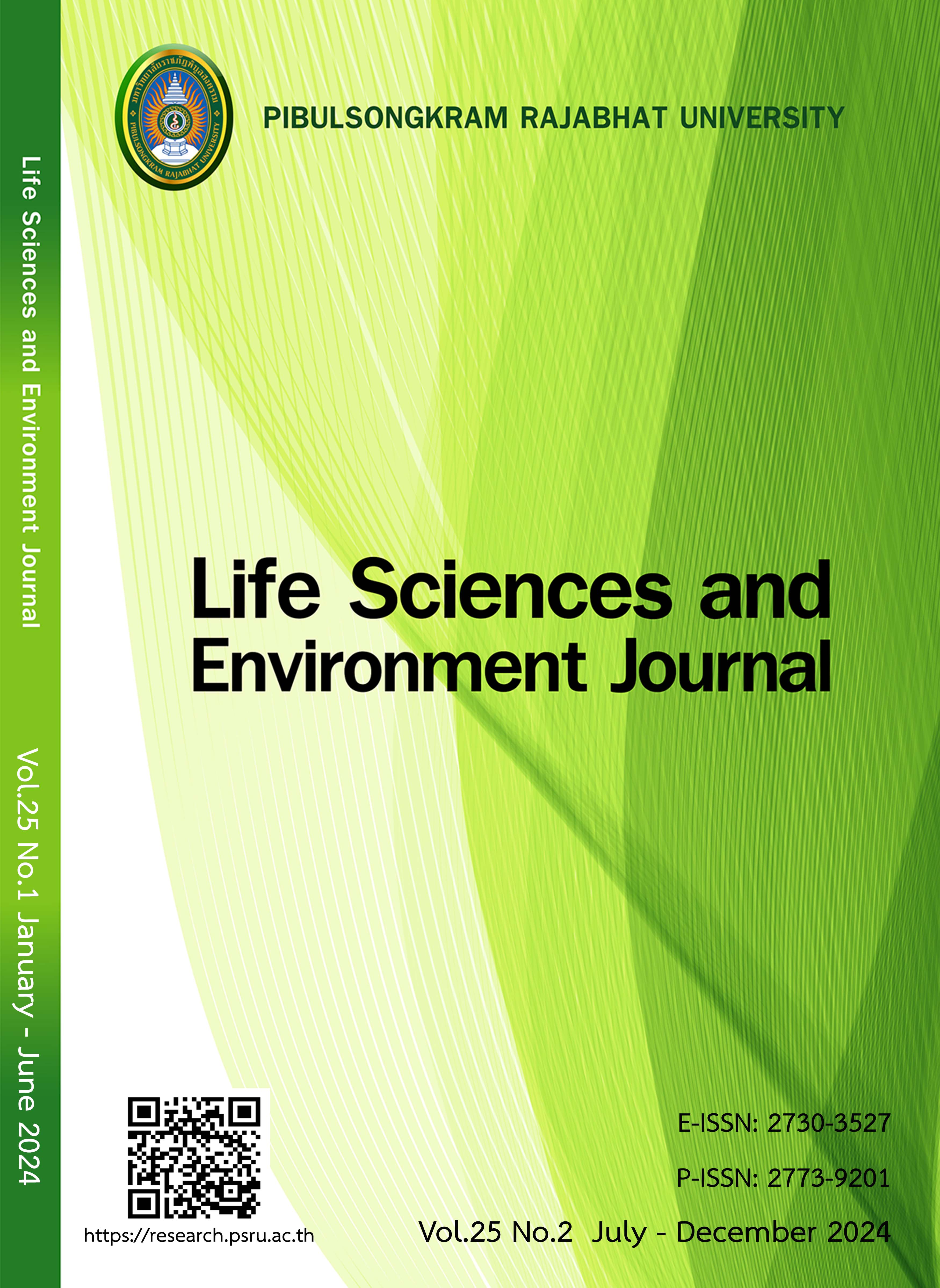EFFECTS OF NEEM WOOD VINEGAR ON ANTIFUNGAL GROWTH OF NAM WAH BANANA ROPE PRODUCTS
DOI:
https://doi.org/10.14456/lsej.2024.21Keywords:
Banana rope, Mold, Wood vinegar, Neem treeAbstract
This research was aimed to examine the influence of neem-wood vinegar on inhibiting fungal growth of banana ‘Namwa Mali-ong’ ropes produced in Chai Badan district, Lopburi province. The experiment was conducted using banana rope samples prepared by four methods: Rope_A (control sample), Rope_B (bleached with sodium hypochlorite), Rope_AN (treated with neem-wood vinegar), and Rope_BN (bleached with sodium hypochlorite and treated with neem-wood vinegar). The results showed the growth of white mycelium fungi in the Rope_A sample only. Sodium hypochlorite and neem wood vinegar solutions could inhibit the growth of the white mycelium fungi. After 30 days of storage at natural condition, 3 mycelium fungi (white, black and green mycelium fungi) were found in Rope_A30 sample (Rope_A after 30 days of storage at natural condition). While Rope_B30, Rope_AN30, and Rope_BN30 samples (banana ropes bleached with sodium hypochlorite and/or treated with neem-wood vinegar after 30 days of storage at natural condition) showed only black mycelium fungi and their numbers were less than in the Rope_A30 sample. This research indicated that sodium hypochlorite and neem wood vinegar could inhibit and reduce fungal growth during product storage but decrease the tensile strength of banana rope products. Neem wood vinegar affected strength reduction less than sodium hypochlorite but increased darkness in banana rope color.
References
Chayawat C. Inoculation method and effect of water-logging on Aspergillus flavus inflection in Peanut. Master of Science Program in Agronomy Thesis, Graduate School, Chiang Mai University; 2004.
Chimvaree C, Boonyaritthongchai P, Poubol J. Effect of sodium hypochlorite solution dipping on microbial population changes of fresh-cut ‘Red Maradol’ papaya. Agricultural Science Journal 2017;48(3):253-256.
Chungsiriporn J, Pongyeela P, Iewkittayakorn J. Use of wood vinegar as fungus and malodor retarding agent for natural rubber products. Songklanakarin Journal of Science and Technology 2018;40(1):87-92.
Chungsiriporn J, Pongyeela P, Kantakapun K, Chairerk N. Application of wood vinegar for antifungal growth on natural rubber sheet. King Mongkut's Agricultural Journal 2020;38(3):351-355.
Database to promote and enhance the quality of OTOP products. Banana processing. 2019. Source: http://otop.dss.go.th/index.php/en/knowledge/interesting-articles/340-2019-12-11-02-25-03. Accessed March 25, 2024.
Duamkhanmanee R. The application of wood vinegar for controlling sclerotium rolfsii sacc. causing damping-off disease in tomato (Research Report). Phranakhon Si Ayutthaya: Rajamangala University of Technology Suvarnabhumi; 2015.
Jústiz-Smith NG, Virgo GJ, Buchanan VE. Potential of jamaican banana, coconut coir and bagasse fibres as composite materials. Materials Characterization 2008;59(9):1273-1278.
Khongsai S, Chalad C, Na - Ranong S. Sulfur dioxide emission from Nypa Fruitcans ’s leaf curing. Rajamangala University of Technology Srivijaya Research Journal 2012;4(2):23-30.
Kimnarak P. Distribution of fungi in medical technology laboratory: case study of medical technology laboratory, nakhon phathom hospital, nakhon pathom province. Master of Science Program in Environmental Science Thesis, Graduate School, Silpakorn University; 2015.
Kongkeaw P, Ratchapho T. The studies of the mechanical and physical properties of plastic reinforced with banana (Musa) and Coconut Coir Fiber (Research Report). Maha Sarakham: Rajabhat Maha Sarakham University; 2015.
Mahawan K, Doungsa-ard C, Nalumpang S. Efficiency of eucalyptus wood vinegar in controlling Colletotrichum truncatum s. l. causing vegetable soybean anthracnose of cabendazim resistance. Khon Kaen Agriculture Journal 2019;47(2):235-248.
Mohanty AK, Misra M, Drzal LT. Natural fiber, biopolymers, and biocomposites. 1st ed. USA: CRC Press; 2005.
Pattarasaikul W, Soytong K, Poeaim S. Biological control of anthracnose disease on banana var ‘Namwa Mali-Ong’ by Neosartorya species. International Journal of Agricultural Technology 2018;14(7): 1589-1598.
Phuengwongyat P. Wood vinegar from the charcoal kiln. Technologychaoban 2002;15(301):31-32.
Ponkham P, Thancharoen K, Thongthammachat S, Wangkulangkul M, Wanich S. The study of antifungal effect of organic acid against the mat fungi (Research Report). Maha Sarakham: Rajabhat Maha Sarakham University; 2017.
Rattanakreetakul C, Rangsuwan S, Pongpisutta R, Keawmanee P. Detection of aflatoxin producing aspergillus flavus with the primer afl R. The Agricultural Science Journal 2021;52(2):53-56.
Saepaisan S, Thonroshrapee V. Efficiency of fungicides in controlling the fungal pathogens, causing crown rot disease of cultivated. Khon Kaen Agriculture Journal 2019;47(suppl. 1):1657-1664.
Sangnak V, Nalumpang S. Efficiency of wood vinegar extracts from eucalyptus and neem trees for controlling Colletotrichum gloeosporioides. Journal of Agriculture 2010;26(3):213-222.
Saortap W, Piasai O, Chaijuckam P. Identification of Aspergillus spp. and Penicillium spp. contaminated in food, agriculture products and cultivated soil and aflatoxin B1 production. The Agricultural Science Journal 2017;48(1):127-113.
Sirtes G, Waltimo T, Schaetzle M, Zehnder M. The effects of temperature on sodium hypochlorite short-term stability, pulp dissolution capacity, and antimicrobial efficacy. Journal of Endodontics 2005; 31(9):669-671.
Somchai P, Suyanandana P, Artjariyasripong S. Antifungal control of handicrafts made from water-hyacinth fibre. The 31st Kasetsart University Annual Conference 1993; 207-215.
Suthanukool P. Research and development of banana production for improvement of quality production and high value-added products (Research Report). Bangkok: Department of Agriculture, Ministry of Agriculture and Cooperatives; 2015.
Suwan N. Isolation and characterization of antagonistic bacteria to control postharvest disease of Karen chili. Master of Science Program in Plant Pathology Thesis, Graduate School, Chiang Mai University; 2012.
Suwancharoen S, Boonmee A. Chemical constituents and antifungal activities of pyroligneous acid from mangosteen fruit and branch (Research Report). Chanthaburi: Rambhai Barni Rajabhat University; 2015.
Toomthongkum N. Study and development of prolong process from local wisdom for bamboo product (Research Report). Phetchabun: Phetchabun Rajabhat University; 2015.
Viroj J. Physicochemical properties of wood vinegar from neem trees, eucalyptus trees, corn trees, and mango leaves. Journal of Science and Technology Mahasarakham University 2019;39(1):136-143.
Vorapunthu S, Nuangmek W, Suwannarach N, Pithakpol W. Efficiency of fumigation with volatile from clove, cinnamon and pepper mint essential oil on fungi growth inhibition of water hyacinth handicraft product. Khon Kaen Agriculture Journal 2016;44(1):205-211.
Wattanuruk D. Use of medicinal herb extracts to inhibit fungi of banana slab. The 7th STOU National Research Conference 2007;2312-2318.
Downloads
Published
How to Cite
Issue
Section
License
Copyright (c) 2024 Life Sciences and Environment Journal

This work is licensed under a Creative Commons Attribution-NonCommercial-NoDerivatives 4.0 International License.
Each article is copyrighted © by its author(s) and is published under license from the author(s).










